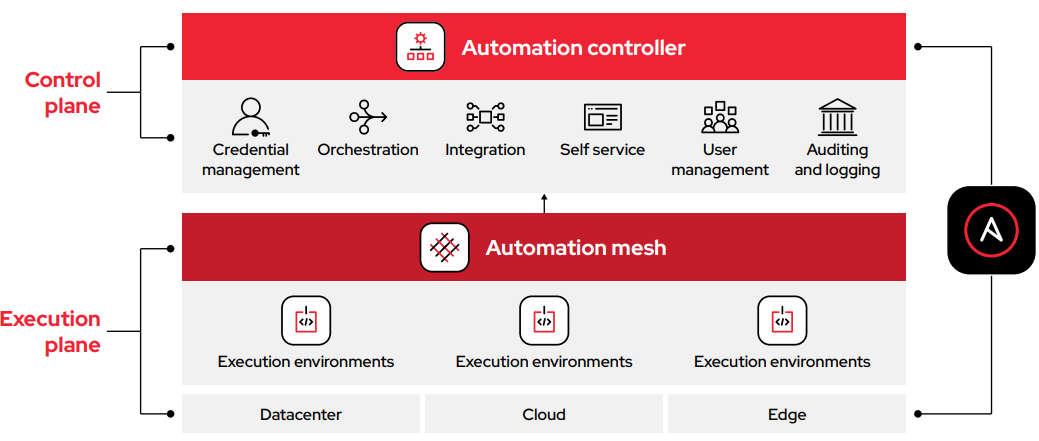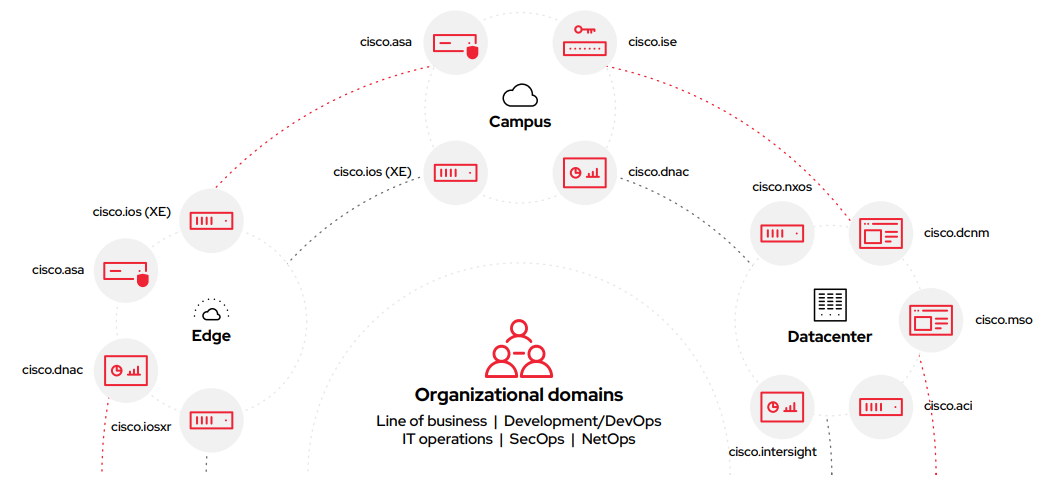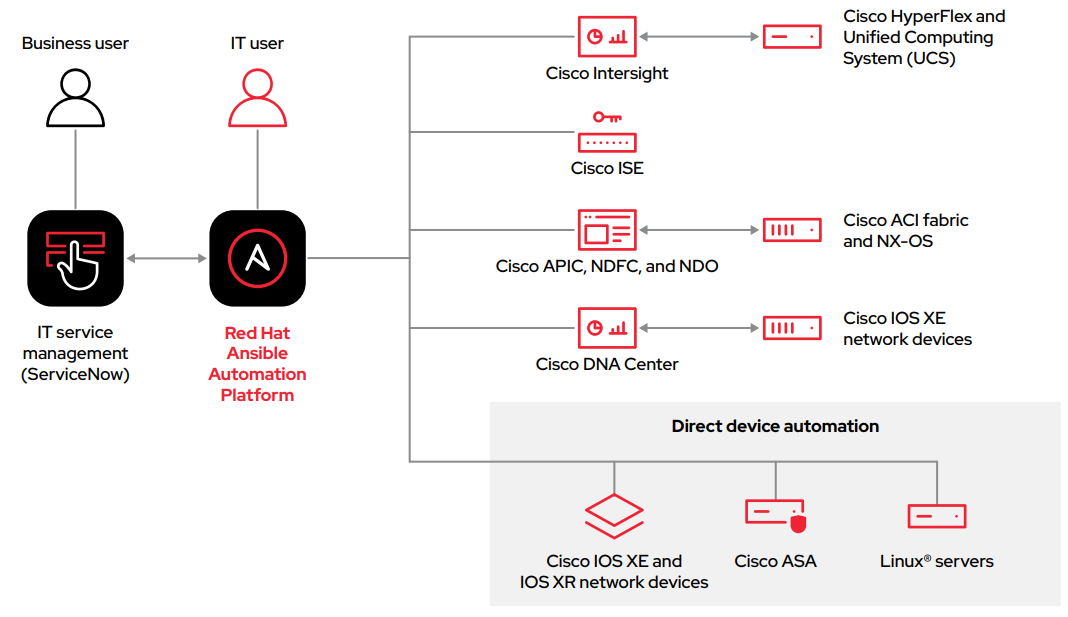Automate Cisco networks with Red Hat Ansible Automation Platform
Accelerate business outcomes while adopting cloud-native technologies
Today’s businesses are responding to unprecedented change by adopting cloud-native technologies and modernizing their IT environments and processes. IT modernization is all about finding smarter ways to do business. However, many IT operations teams manage increasingly complex IT architectures built on multiple platforms and complicated technology stacks. Adding cloud-native technologies compounds this challenge. At the same time, IT teams also need to control—and often reduce—costs while improving the resiliency of essential network services.
Automation can help your organization gain control over IT complexity. In fact, 80% of surveyed business executives say that adopting IT automation is “extremely important” to the future success of their organization.1 Applying IT automation to your network management can boost speed, consistency, and accuracy. For example, network automation allows network operations (NetOps) teams to configure, scale, protect, and integrate network infrastructure and application services more quickly and efficiently. Streamlined management and orchestration are critical when working in cloud-native environments, and network automation plays a key role in cloud and IT modernization journeys. Studies show that technology organizations believe datacenter network automation can drive operational efficiency, reduce security risk, and improve compliance and digital agility.2
Streamline management and control costs through network automation
As IT environments expand, the networks that connect resources, infrastructure, and services become more complicated to manage. Even now, networks are often built, operated, and maintained using mostly manual processes. NetOps staff log in to network components, change configurations by hand, then log out. Many organizations use a variety of tools and platforms to manage different aspects of their network—including switching, routing, and firewalls—making it difficult to understand and orchestrate your network as a whole. And changes may not be tracked or validated, resulting in compliance issues and inconsistencies.
Network automation can alleviate these challenges, allowing NetOps teams to become more agile and flexible and support modern business demands. Even so, adoption of automation solutions has been much slower among network teams than expected for several reasons. Device-specific tools are often tough to incorporate into automation tooling. Policy-driven network configuration requirements can impede integration of multivendor environments. And many NetOps professionals simply feel unprepared or lack the skills to take advantage of automation technologies for specific network integrations. As a result, nearly 77% of technology professionals see room for improvement in their datacenter network automation strategy.2
Red Hat and Cisco can help your organization adopt network automation simply and efficiently.
Red Hat and Cisco work together to deliver the platforms and integrations needed for efficient, automated network operations. Our solutions can help your organization:
- Streamline network management operations.
- Improve your team’s ability to respond rapidly to changes.
- Identify and fix security vulnerabilities across your entire network.
- Ensure continuous compliance with policies and regulations.
- Increase network resiliency through effective testing and management.
Run your network more efficiently with Red Hat and Cisco
Red Hat and Cisco work together to deliver the platforms and integrations needed for efficient, automated NetOps. A foundation for building and operating automation at scale, Red Hat® Ansible® Automation Platform lets you create and orchestrate complete IT workflows that support your business goals. It can orchestrate all aspects of your IT environment, from servers and networks to applications, security, and DevOps. With Ansible Automation Platform, you can automate Day 0, Day 1, and Day 2 operations to accelerate network transformation and adopt an efficient, responsive operating model.
Ansible Automation Platform offers certified, supported automation content to extend platform capabilities, expand automation across domains, and ease adoption. Certified Content Collections for a variety of Cisco devices, platforms, and technologies—including network device operating systems, security appliances, software-defined networking (SDN) controllers, and network visibility platforms—let you automate Cisco networks effectively and with confidence.
Ansible Automation Platform makes tasks repeatable and scalable so you can run your entire Cisco network more efficiently. Choose to automate where you need it most. The platform’s flexible framework embraces incremental change, allowing you to start small and expand over time. For example, you can:
- Use Cisco Validated Designs (CVDs) to ease implementation, reduce deployment time, and improve total cost of ownership (TCO).
- Reduce the number of manual tasks to provide error-free, repeatable configurations.
- Validate changes on a continuous basis to ensure compliance.
Ansible Automation Platform offers many benefits for organizations running Cisco networks.
Take advantage of industry leadership
As industry leaders and experts, Red Hat and Cisco bring innovative, tested, and integrated joint solutions to market, saving your organization time and money. We work together to incorporate the latest technologies, validate integrations, update solutions and reference architectures, and train support engineers to help your teams keep pace with changing technology and approaches.
Get started faster with certified integrations
The following table shows supported Cisco products by category. Click on each entry to access the associated certified automation integrations in Ansible Automation Hub, a centralized repository for automation content. A Red Hat login is needed for access—you can register for a login and no-cost trial subscription at developers.redhat.com/products/ansible/overview.
| Product area | Certified integrations | |
| Network device operating systems |
||
| Network security | ||
| SDN controllers | ||
| Infrastructure life cycle management |
||
| Network visibility |
|
|
Simplify network automation adoption
With a human-readable language, visual user interface, and ready-to-use content, Ansible Automation Platform helps you get started with network automation more easily. No special programming skills are required, so NetOps engineers can start using the platform immediately. It also minimizes the need to understand platform- and vendor-specific constructs, command lines, implementations, and application programming interfaces (APIs). Access to certified, supported content from network partners helps you create robust, enterprise workflows. You can also use existing command-line interfaces (CLIs) and APIs directly within the platform. Ansible Automation Platform serves as an abstraction layer, so you can implement network configurations as code and design workflows using a common set of states and commands across devices—the platform takes care of translating your commands for each endpoint via resource modules.
Create complete network—and IT—workflows
Ansible Automation Platform provides an efficient, comprehensive platform for true end-to-end automation that helps your organization accelerate business outcomes and return on investment (ROI). Users across your organization can share, vet, and manage automation content. IT managers can provide guidelines on how automation is applied to individual teams. Meanwhile, automation creators retain the freedom to write tasks that use existing knowledge, without the operational overhead of conforming to complex tools and frameworks.
Ansible Automation Platform lets you connect all parts of your IT environment to create complete, cross-domain workflows. You can manage your Cisco network infrastructure throughout the entire production life cycle:
- Automate configuration of your Cisco network stack.
- Document, track, and manage Cisco network operational states.
- Continuously track and check compliance of Cisco network operational states.
You can also incorporate your existing tools and interfaces into larger processes to eliminate time-consuming hand-offs, foster collaboration, and allow other teams to perform network tasks in a predefined, automated manner. For example, NetOps, IT operations, and security operations teams can use a common interface and language to automate complex cross-domain processes, with each team writing their own automation content. Additionally, you can interact with nearly all Cisco-related devices, controllers, and programs connected to your network via common IT service management (ITSM) tools and platforms for smooth, intuitive operations. An example of this is shown in Figure 3 — ServiceNow is used as the front end interface for automating and controlling Cisco network components.
You can also incorporate your existing tools and interfaces into larger processes to eliminate time-consuming hand-offs, foster collaboration, and allow other teams to perform network tasks in a predefined, automated manner. For example, NetOps, IT operations, and security operations teams can use a common interface and language to automate complex cross-domain processes, with each team writing their own automation content. Additionally, you can interact with nearly all Cisco-related devices, controllers, and programs connected to your network via common IT service management (ITSM) tools and platforms for smooth, intuitive operations. An example of this is shown in Figure 3 — ServiceNow is used as the front end interface for automating and controlling Cisco network components.
Using Ansible Automation Platform, you can begin your journey to organization-wide automation with three simple actions:
- Create. Get started in less time by accessing ready-to-use certified and validated Content Collections for a wide variety of network products from a large number of vendors. Codify your infrastructure and share automation assets across teams and individuals to deploy and manage infrastructure on-site or in cloud environments.
- Manage. Standardize how automation is deployed, initiated, delegated, and audited. With the automation controller, users from multiple teams can reliably and consistently scale automation on demand, taking a systematic approach to standardizing automation practices — while helping to reduce automation irregularities across your enterprise.
- Scale. Transfer your automation to multiple domains and across different use cases. Stakeholders in developer, operator, and line-of-business teams can engage with automation in ways that work best for them and make sense for their individual roles without slowing development time.
Read The automated enterprise e-book to learn more about creating an organization-wide automation strategy.
Improve network security and compliance
Automating your Cisco network with Ansible Automation Platform can help you improve network security and adopt NetSecOps approaches. Rapidly identify vulnerabilities and implement fixes across your entire network. Build and maintain an inventory of devices and configuration to gain visibility into your network status. Adopt an event-driven approach and telemetry to automatically respond to security risks and address simple issues, so staff can focus on more complex and sophisticated attack vectors.
Ansible Automation Platform can also help you ensure continuous compliance with changing policies and regulations across your entire Cisco network. Implement a centralized source of truth for GitOps processes. Automatically test changes before committing them. Validate that changes were made appropriately. And automate auditing tasks and change logging to support compliance operations.
Do more with event-driven automation
Event-driven automation is the next step in the journey to end-to-end IT automation. Part of Ansible Automation Platform, Event-Driven Ansible lets you rapidly create advanced automation scenarios for a wide variety of operational needs across your IT infrastructure. It connects sources of operational intelligence and service requests to decision making to rapidly, consistently, and automatically initiate predefined actions when specified events or conditions occur.
For example, Ansible Automation Platform works with Cisco ThousandEyes to apply event-driven automation capabilities to your network. With advanced observability capabilities, ThousandEyes serves as the event source for Event-Driven Ansible. As network conditions change, alerts and management needs can be automatically addressed to optimize the use of network data, save time, and free your NetOps teams to focus on other priorities.
IT executives who need to move to a more proactive response to incidents will find Event-Driven Ansible a complement to existing observability solutions. By triggering off observability or other monitoring solutions, Event-Driven Ansible can take action in realtime to resolve issues.
Look to the future of network automation
IT automation strategies continue to evolve to meet ever-changing business requirements. Ansible Automation Platform gives you the flexibility to automate nearly every aspect of your IT environment, so you can adapt rapidly to change. Red Hat continues to add new capabilities to the platform, including event-driven automation, private automation content repositories, and new certified content. Future complementary capabilities may include generative artificial intelligence (AI) features to help network automation content developers create new workflows even faster and more easily.
Learn more
Network automation is essential for adopting new cloud-native technologies and modernizing your IT. Together, Red Hat and Cisco help you adopt automation rapidly and smoothly. Red Hat Ansible Automation Platform gives you everything you need to automate your existing Cisco networks and adapt as your environment and needs evolve. Get started now with certified content for Cisco solutions and begin realizing the benefits of network automation today.
- Learn about network automation use cases.
- Get started with interactive labs.
- Try Ansible Automation Platform at no cost.
- Learn more about using Ansible Automation Platform with Cisco networks.
- Learn more about our partnership.
Harvard Business Review Analytic Services, sponsored by Red Hat. “Taking the lead on IT automation: IT leaders as evangelists for their automation strategies,” January 2022.
EMA Research Report Summary, sponsored by Red Hat. “The Future of Data Center Network Automation,” February 2022.
IDC Link, “AnsibleFest 2022: Red Hat Ansible Expands to AWS and into Event-Driven Automation, Project Wisdom Looks to the Future of AI,” October 2022. Document #US49797022.
About Cisco
Cisco (NASDAQ: CSCO) is the worldwide technology leader that securely connects everything to make anything possible. Our purpose is to power an inclusive future for all by helping our customers reimagine their applications, power hybrid work, secure their enterprise, transform their infrastructure, and meet their sustainability goals. Discover more on The Newsroom and follow us on Twitter at @Cisco.


